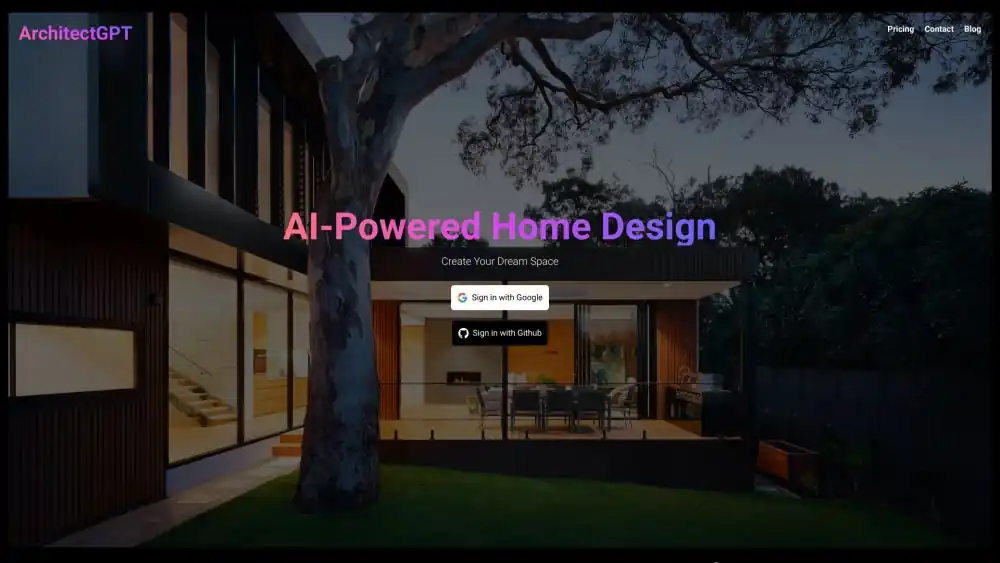ArchitectGPT: Your AI-Powered Design Partner
ArchitectGPT is your intelligent companion in the world of architecture and design. This cutting-edge AI platform offers a revolutionary approach to conceptualization, planning, and visualization.
From generating initial design concepts to creating detailed blueprints, ArchitectGPT streamlines the entire architectural process. With its advanced algorithms and vast knowledge base, it provides architects, designers, and even homeowners with innovative solutions and unparalleled efficiency.
Experience the future of architecture with ArchitectGPT.
Are you ready to transform your design process?
ArchitectGPT: Pros and Cons
Pros
- Efficiency: Significantly reduces design and planning time.
- Innovation: Generates creative and unique design concepts.
- Accessibility: Democratizes architecture by making design tools accessible to a wider audience.
- Cost-effective: Potentially reduces costs associated with traditional design processes.
- Accuracy: Leveraging AI, it can produce highly accurate and detailed designs.
Cons
- Dependency: Overreliance on AI might hinder the development of human design intuition.
- Data privacy: Concerns about the handling of user data and intellectual property.
- Limitations: AI might not be able to capture all nuances of human creativity and design sensibilities.
- Technical issues: Potential for software bugs or performance issues.
- Ethical considerations: Raises questions about the role of AI in the creative process and potential job displacement.
Would you like to focus on a specific aspect of ArchitectGPT, such as target audience or pricing strategy?
ArchitectGPT Pricing Strategies
Given the complexity and potential value of ArchitectGPT, several pricing models could be considered:
Subscription-Based
- Tiered plans: Offer different subscription levels with varying features and capabilities.
- Basic: Core functionalities, limited design options, and basic support.
- Pro: Advanced features, expanded design capabilities, and priority support.
- Enterprise: Comprehensive toolset, custom integrations, and dedicated account management.
- Monthly or annual billing: Provide flexibility for users to choose their preferred payment cycle.
Credit-Based
- Pay-as-you-go: Users purchase credits to generate designs, simulations, or other services.
- Credit bundles: Offer discounted credit packages for bulk purchases.
Project-Based
- Custom pricing: Quote based on project complexity and scope.
- Fixed-price packages: Offer pre-defined packages for common architectural tasks.
Hybrid Model
- Combination: Combine elements from different models to cater to diverse user needs. For example, a freemium model with in-app purchases for advanced features.
Key Considerations
- Value perception: Ensure pricing aligns with the perceived value of the platform and its capabilities.
- Competitor analysis: Research pricing strategies of similar AI-powered design tools.
- Target audience: Consider the pricing preferences of the target market (architects, designers, homeowners).
- Revenue goals: Determine the desired revenue generation and pricing structure accordingly.
- Free trials: Offer free trials to allow users to experience the platform before committing.
By carefully considering these factors and experimenting with different pricing models, ArchitectGPT can find the optimal strategy to maximize revenue and customer satisfaction.
Would you like to explore any of these options in more detail or discuss potential pricing points?
ArchitectGPT Alternatives
While ArchitectGPT offers a unique approach to architectural design, several other tools and software compete in the market:
Traditional Architectural Software
- AutoCAD: Industry standard for 2D and 3D drafting and design.
- Revit: Building Information Modeling (BIM) software for architectural design and construction.
- SketchUp: User-friendly 3D modeling software for architecture, interior design, and product design.
AI-Driven Design Tools
- Generative Design platforms: Focus on generating design options based on specific parameters and constraints.
- Virtual and Augmented Reality tools: Provide immersive experiences for design visualization and presentation.
Key Differentiators for ArchitectGPT
To stand out from the competition, ArchitectGPT should emphasize:
- AI-driven innovation: Highlight the unique capabilities of its AI in generating creative and efficient designs.
- Ease of use: Focus on a user-friendly interface and intuitive workflow.
- Integration: Consider integrations with other architectural software and platforms.
- Industry focus: Target specific architectural niches or markets (e.g., residential, commercial, sustainable design).
By understanding the competitive landscape and emphasizing its unique selling points, ArchitectGPT can position itself effectively in the market.
Would you like to explore potential partnerships or marketing strategies for ArchitectGPT?
ArchitectGPT FAQs
General Questions
- What is ArchitectGPT? ArchitectGPT is an AI-powered platform that assists architects and designers in the conceptualization, planning, and visualization of buildings.
- Who can use ArchitectGPT? ArchitectGPT is designed for architects, designers, engineers, and even homeowners who want to explore design possibilities.
- Is ArchitectGPT available on all devices? ArchitectGPT is primarily a web-based platform, accessible through web browsers for optimal performance.
Features and Functionality
- What kind of designs can I create with ArchitectGPT? ArchitectGPT can generate designs for residential, commercial, and industrial buildings, as well as interior design concepts.
- Do I need architecture experience to use ArchitectGPT? While architectural knowledge is beneficial, ArchitectGPT is designed to be user-friendly and accessible to users with varying levels of expertise.
- Can I collaborate with others on ArchitectGPT? Collaboration features are under development and will be available in future updates.
Pricing and Plans
- How much does ArchitectGPT cost? ArchitectGPT offers various pricing plans to suit different needs, including subscription-based and project-based options.
- What is included in the free plan? A free plan with limited features might be available to introduce users to the platform.
- Can I cancel my subscription at any time? Yes, you can cancel your subscription at any time, depending on the terms of your plan.
Support and Assistance
- How can I get help with ArchitectGPT? ArchitectGPT provides online help resources, tutorials, and customer support to assist users.
- Is there a customer support team? Yes, a dedicated customer support team is available to address user inquiries and issues.
Would you like to add more FAQs or expand on any of these?
Conclusion: ArchitectGPT – The Future of Design
ArchitectGPT represents a significant leap forward in the field of architecture and design. By harnessing the power of AI, it offers a revolutionary approach to conceptualization, planning, and visualization.
With its potential to streamline workflows, enhance creativity, and improve design outcomes, ArchitectGPT has the potential to transform the industry. However, addressing challenges such as data privacy, ethical considerations, and continuous AI development will be crucial for its long-term success.
As AI technology continues to advance, ArchitectGPT can evolve into an even more powerful and indispensable tool for architects, designers, and clients alike. By focusing on user experience, innovation, and collaboration, ArchitectGPT can establish itself as a leading platform in the field.
Would you like to explore specific marketing strategies or target audience development for ArchitectGPT?
![]()






